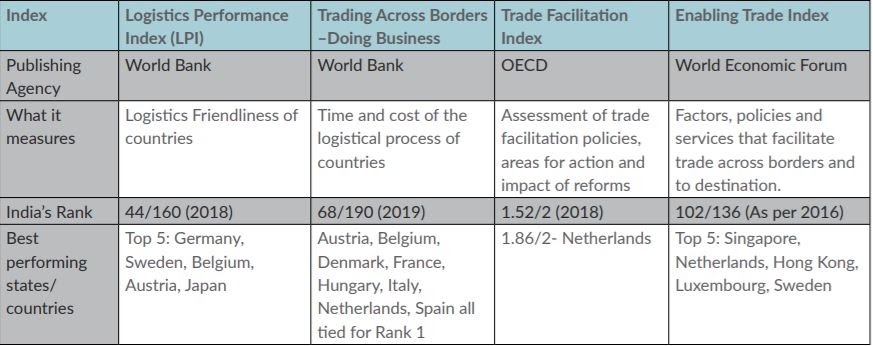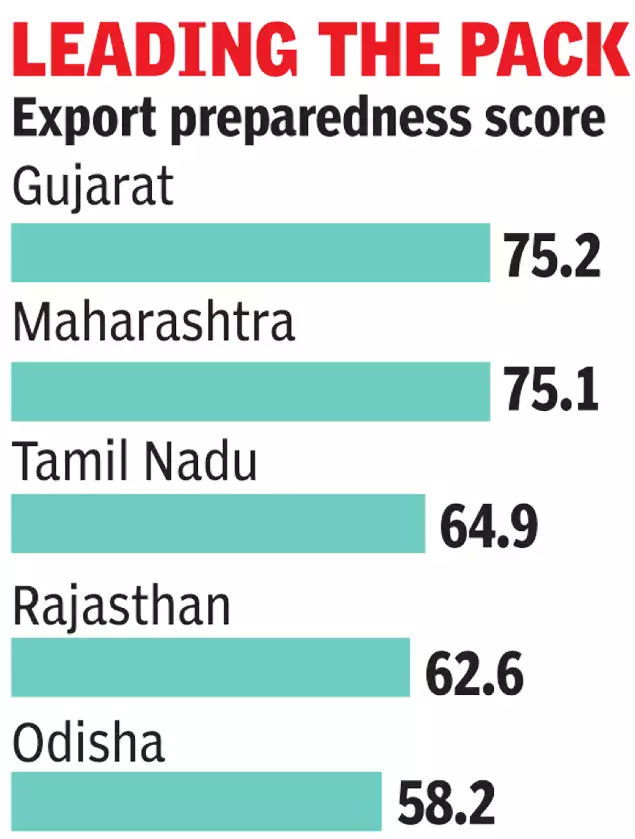Governance
Export Preparedness Index 2020: NITI Aayog
- 27 Aug 2020
- 5 min read
Why in News
Recently, the NITI Aayog in partnership with the Institute of Competitiveness released the Export Preparedness Index (EPI) report 2020.
Key Points
- EPI 2020:
- Aim: To identify challenges and opportunities, enhance the effectiveness of government policies and encourage a facilitative regulatory framework for export.
- Ranking Parameter: The index ranked states on four key pillars:
- Policy: A comprehensive trade policy providing a strategic direction for exports and imports.
- Business Ecosystem: An efficient business ecosystem helping states attract investments and create an enabling infrastructure for individuals to initiate start-ups.
- Export Ecosystem: Assess the business environment, which is specific to exports.
- Export Performance: This is the only output-based parameter and examines the reach ofexport footprints of States and Union Territories.
- Sub-pillars: The index also took into consideration 11 sub-pillars - export promotion policy; institutional framework; business environment; infrastructure; transport connectivity; access to finance; export infrastructure; trade support; R&D infrastructure; export diversification; and growth orientation.
- Features: The EPI is a data-driven effort to identify the core areas crucial for export promotion at the sub-national level (states and union territories).
- Benefit: The Index would be a helpful guide for the state governments to benchmark regional performance with respect to export promotion and thus deliver key policy insights on how to improve and enhance the exports.
- Performance:
- Gujarat has topped the overall EPI 2020 followed by Maharashtra and Tamil Nadu.
- Among the landlocked states, Rajasthan has topped the index, followed by Telangana and Haryana.
- Among the Himalayan states, Uttarakhand topped the index, followed by Tripura and Himachal Pradesh.
- Across Union Territories, Delhi has performed the best.
- India’s Exports:
- India’s merchandise exports have witnessed growth from USD 275.9 billion in 2016-17 to USD 331.0 billion in 2019-20.
- However, the Covid-19 crisis gave a major blow to the current fiscal. Consequently, India’s exports shrank by 60% in April 2020.
- This consistent positive growth has been a result of key measures adopted by the government post-2016 for the promotion of merchandise exports.
- A mid-term review of the Foreign Trade Policy 2015-20 was conducted in 2017 to assess the policy interventions required to boost the export levels.
- A new Logistics Division was established in the Department of Commerce to organize the integrated development of the logistics sector.
- Trade Infrastructure for Export Scheme (TIES) was launched in 2017 to address the existing export infrastructure gaps.
- Agriculture Export Policy was rolled out to target export contribution at a micro-level.
- Transport and Marketing Assistance (TMA) scheme was also introduced for the export of specified agriculture products to mitigate the disadvantage of the higher cost of transportation.
- India’s merchandise exports have witnessed growth from USD 275.9 billion in 2016-17 to USD 331.0 billion in 2019-20.
- Challenges: The export promotion in India faces three fundamental challenges:
- Intra- and inter-regional disparities in export infrastructure.
- Poor trade support and growth orientation among states.
- Poor research & development infrastructure to promote complex and unique exports.
Way Forward
- The per capita exports in India stood at about USD 241, as compared to USD 11,900 in South Korea and USD 18,000 in China. Therefore, Indian economy has a huge potential to become a strong exporter on the world stage. This can be achieved by making India’s states and union territories active participants in the country's export efforts.
- Currently, 70% of India’s export has been dominated by five states- Maharashtra, Gujarat, Karnataka, Tamil Nadu and Telangana.
- Emphasis on key strategies like a development of export infrastructure, strengthening industry-academia linkages and creating state-level engagements for economic diplomacy to address the challenges in exports.
- The private sector can also play an important role in export promotion.
- Increase in exports can help India to achieve the target of making India a developed economy by focusing on ‘Atma Nirbhar Bharat’. The exports can also help generate employment in India.






